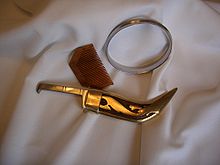Gobind Singh
Guru Gobind Singh Ji ( Punjabi : ਗੁਰੂ ਗੋਬਿੰਦ ਸਿੰਘ; * December 22, 1666 in Patna ; † October 7, 1708 in Nanded , Maharashtra ) was the tenth and last human guru of Sikhism . He was considered a warrior, poet and philosopher.
Life
When the ninth Guru Tegh Bahadur was executed by the Muslim ruler Aurangzeb in 1675 , his head was brought to his son Guru Gobind Rai, who was then nine years old. He then became the tenth and last human guru on November 11, 1675 under the new name Guru Gobind Singh.
In 1699 he founded the Khalsa Brotherhood a . a. as a result of constant harassment and persecution by the Mughal rulers.
The first five baptized by Guru Gobind Singh are called Panj Pyare , the Five Beloved . According to traditional tradition, the Guru was also baptized according to his wishes and took the surname Singh (lion) , which is now valid for all male Sikhs . From then on he was called Guru Gobind Singh. All women were given the surname Kaur (princess; grammatically correct: "Prince"). Shortly before his death, Guru Gobind Singh emphasized that only Guru Granth Sahib , the Holy Scriptures, the eternally living Guru (leader) of the Sikhs will be the highest spiritual / religious authority for all Sikhs.
Guru Gobind Singh Ji was murdered on October 7, 1708 in Nanded , Maharashtra .
K symbolism
All Sikhs baptized by Guru Gobind Singh wore five symbols, which in Punjabi begin with the letter "K":
- Uncut hair (kesh), men cover their uncut hair with a dastar (turban), women with a cloth or dastar (turban)
- A wooden comb (kangha) is worn in the hair as a sign of cleanliness and order.
- Special cotton panties (Kachera), the Kachera symbolizes self-respect and reminds the wearer of the mental control over lust (lust belongs to the five thieves: Kaam / lust, Krodh / anger, lobh / greed, Moh / arrest, Ahankar / ego) in the Sikh philosophy. The kachera stands for true chastity and fidelity in marriage.
- A steel bracelet (Kara), reminds of the obligation to truth and righteousness. The Kara symbolizes the endlessness of God. He is a symbol of the constant bond with God and the Sikh community by being a link in the chain of the Khalsa Panth.
- A dagger ( kirpan ) worn day and night is the sign that the Sikhs defend the weak and innocent. The kirpan is a religious symbol of patience and mercy. It is synonymous with the destruction of tyranny, injustice and oppression. Its use is only permitted for the protection of others and for self-defense, but never for attack. The kirpan is to be worn in a gatra and should never be separated from the body. The kirpan stands for bravery, courage, a noble character, standing up for the righteousness and protection of the weak, innocent and oppressed.
Web links
- Gobind at Wikiquote (English)
- Biography and anecdotes
- The Ten Sikh Gurus (German Information Center for Sikh Religion, Sikh History, Culture and Science)
- Trumpp, Ernst: Janam Sākhī of Guru Govind (biography of the last guru of the Sikhs) - BSB Cod.panj. 9
Individual evidence
- ↑ http://www.bridica.com/EBchecked/topic/236565/Gobind-Singh
- ^ Johann Figl : Handbuch Religionswissenschaft: Religionen und their central themes Verlag Vandenhoeck & Ruprecht, 2003, page 372 ff, ISBN 3-7022-2508-0 [1]
- ↑ India: Approaches , Verlag Fischer Rudolf, 2006, ISBN 3-906090-29-9 , page 113, [2]
| personal data | |
|---|---|
| SURNAME | Gobind Singh |
| ALTERNATIVE NAMES | Gobind Singh Ji, Guru |
| BRIEF DESCRIPTION | tenth and final guru of Sikhism |
| DATE OF BIRTH | December 22, 1666 |
| PLACE OF BIRTH | Patna |
| DATE OF DEATH | October 7, 1708 |
| Place of death | Nanded , Maharashtra |
